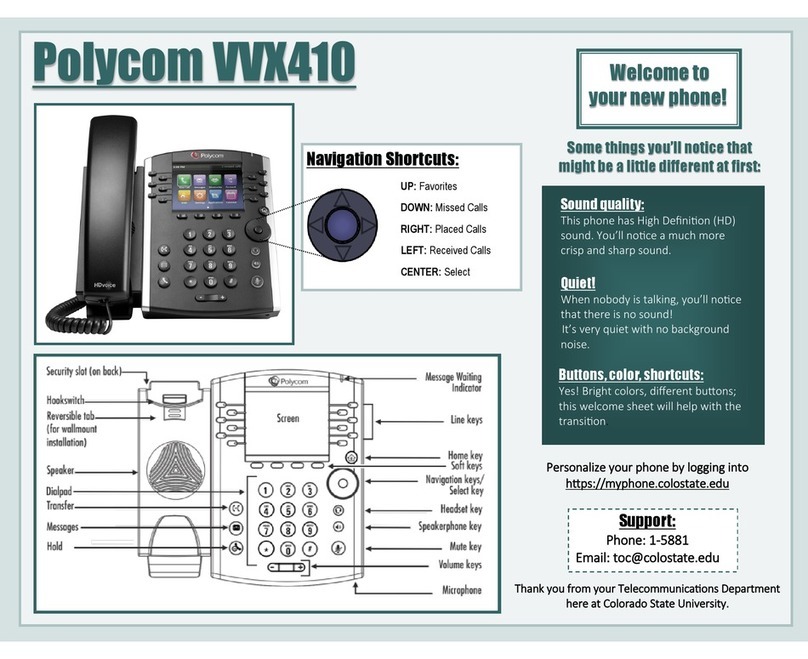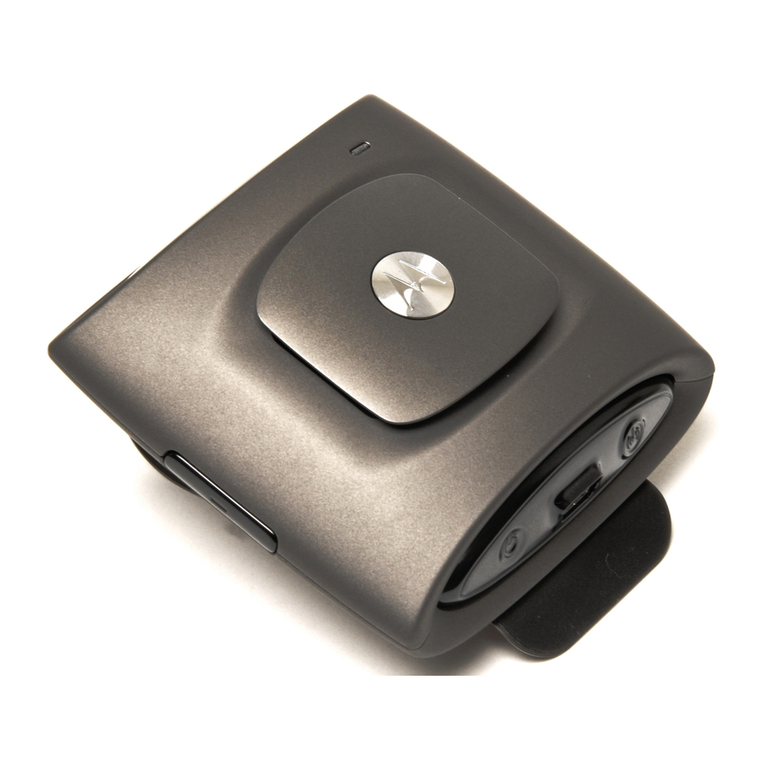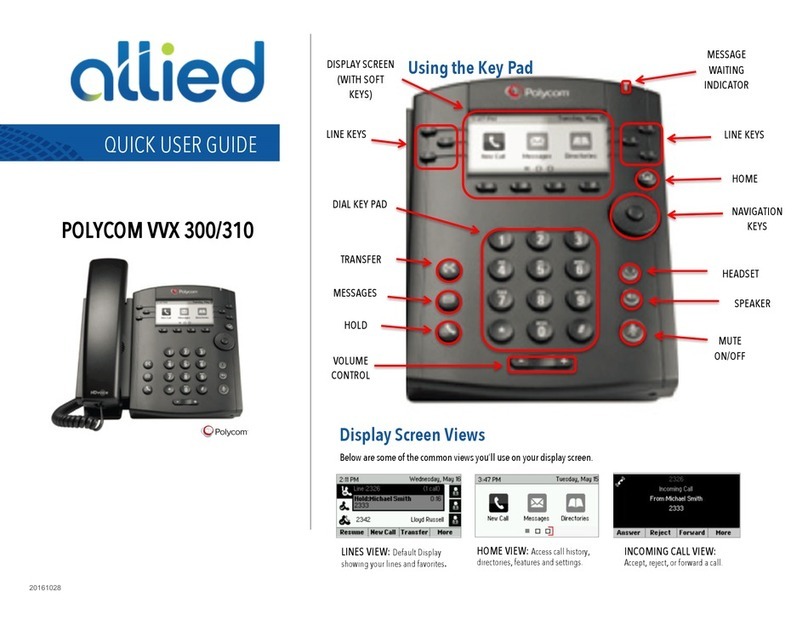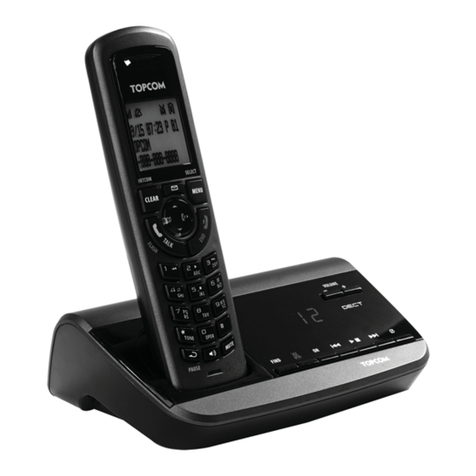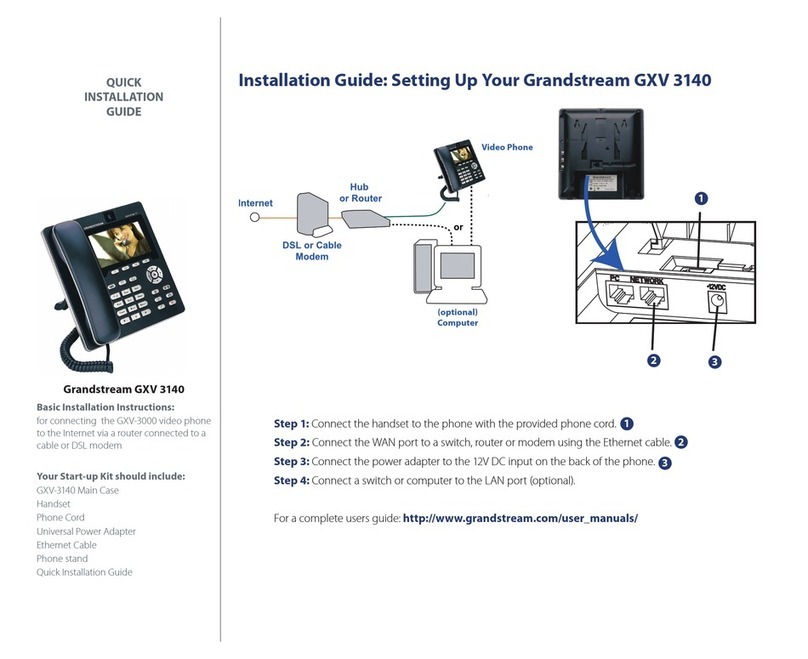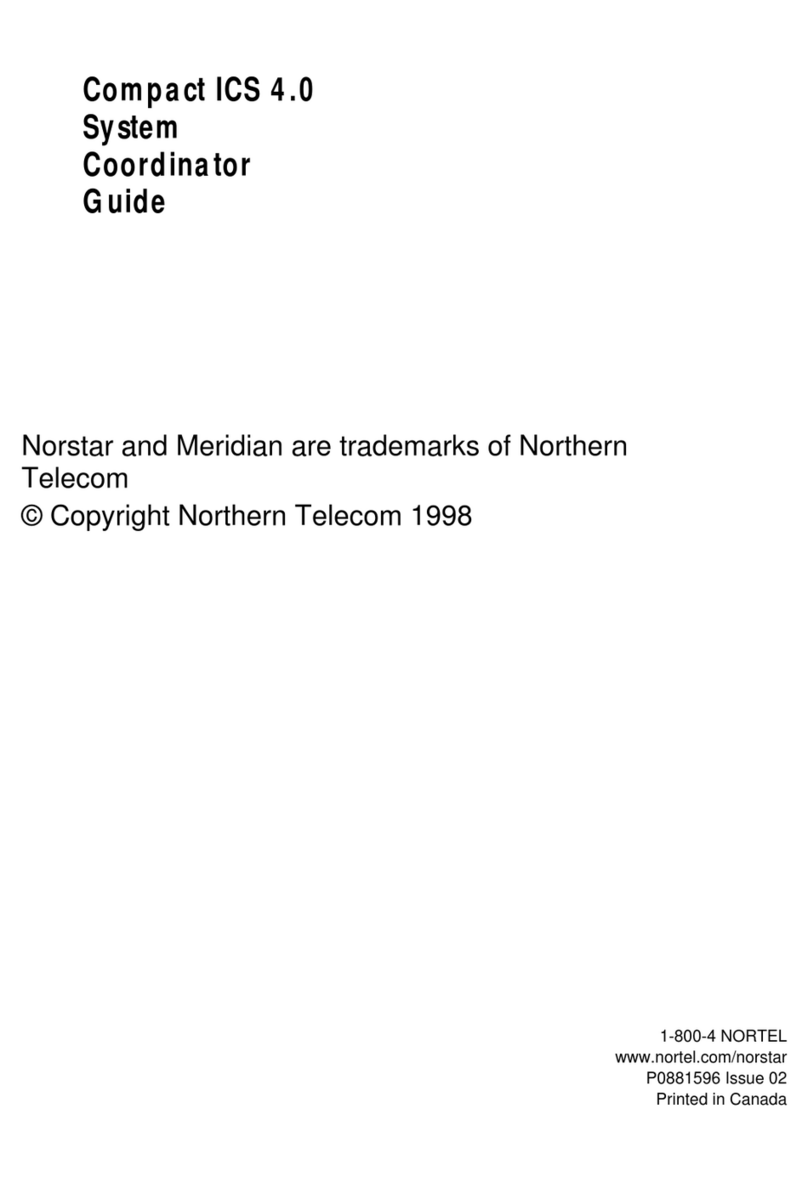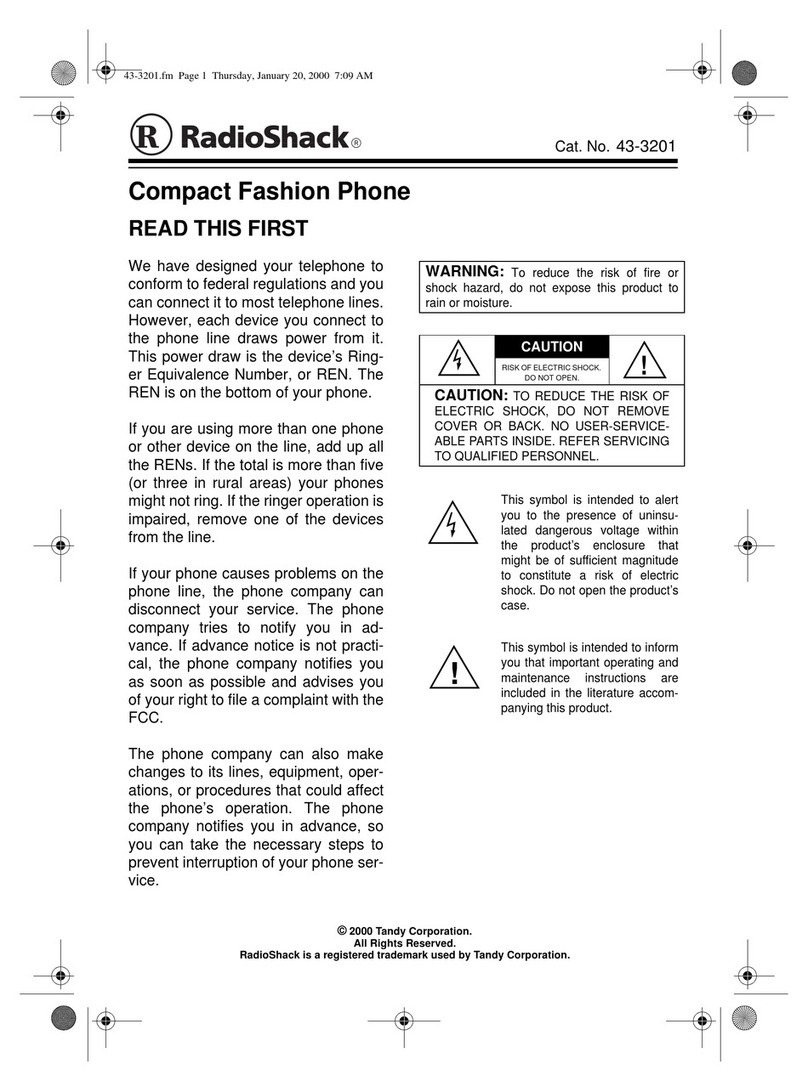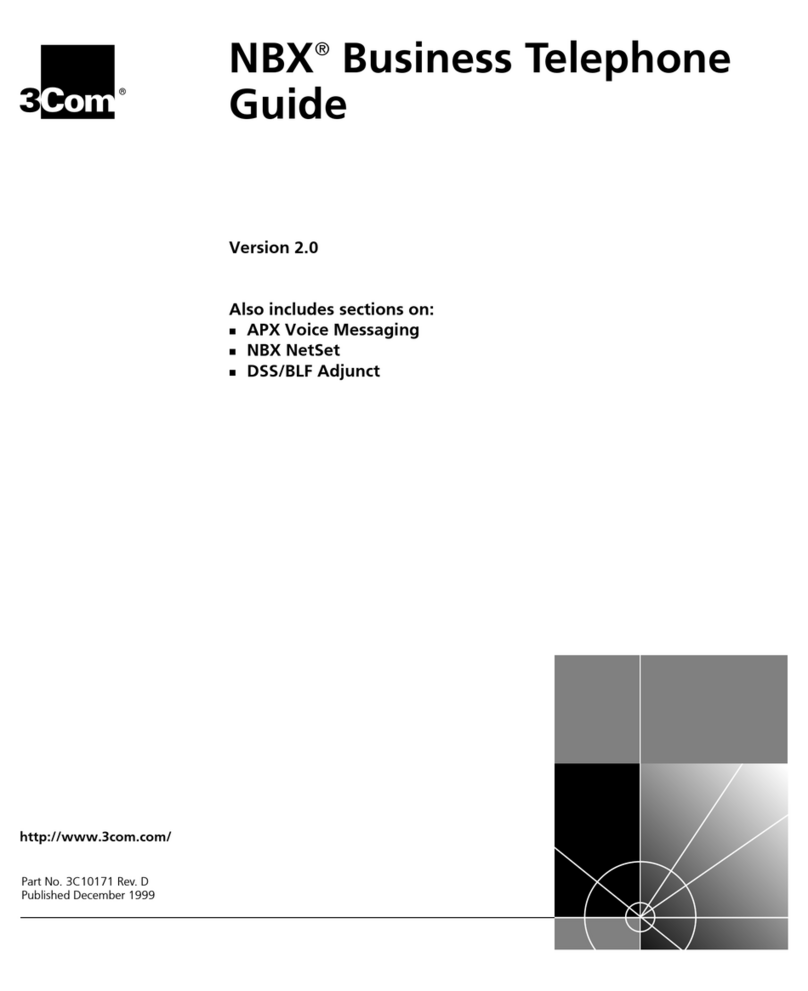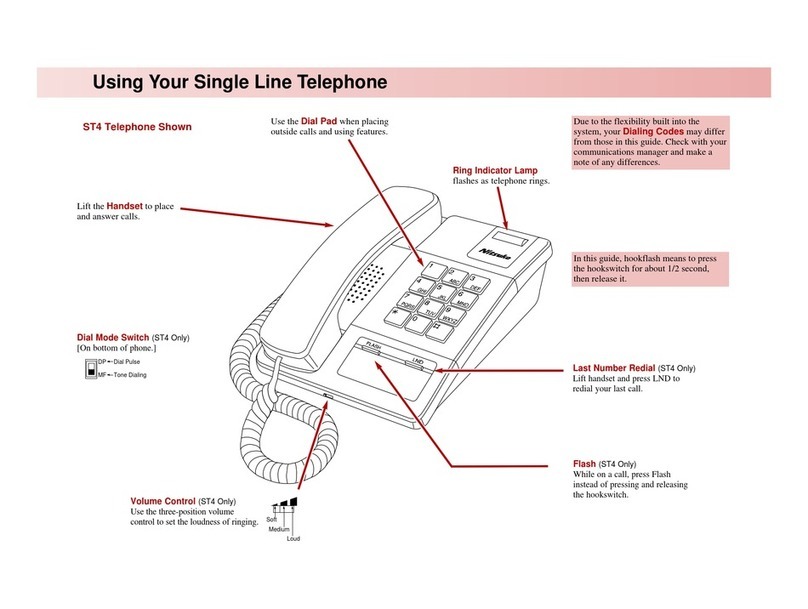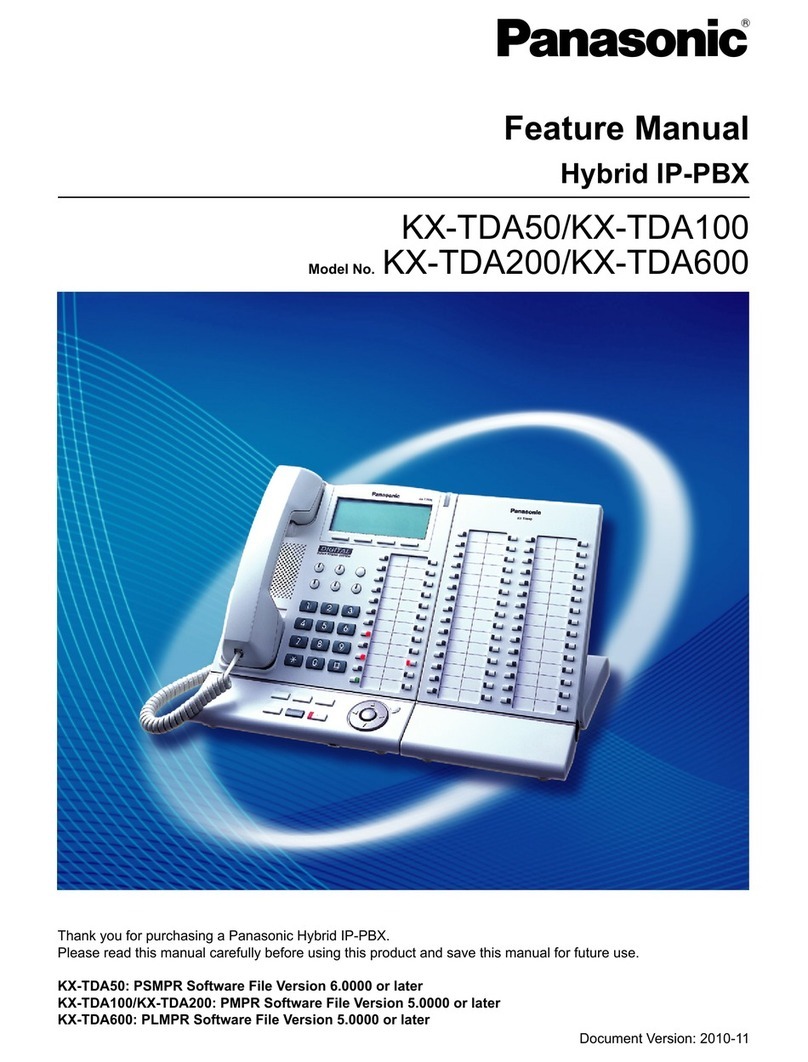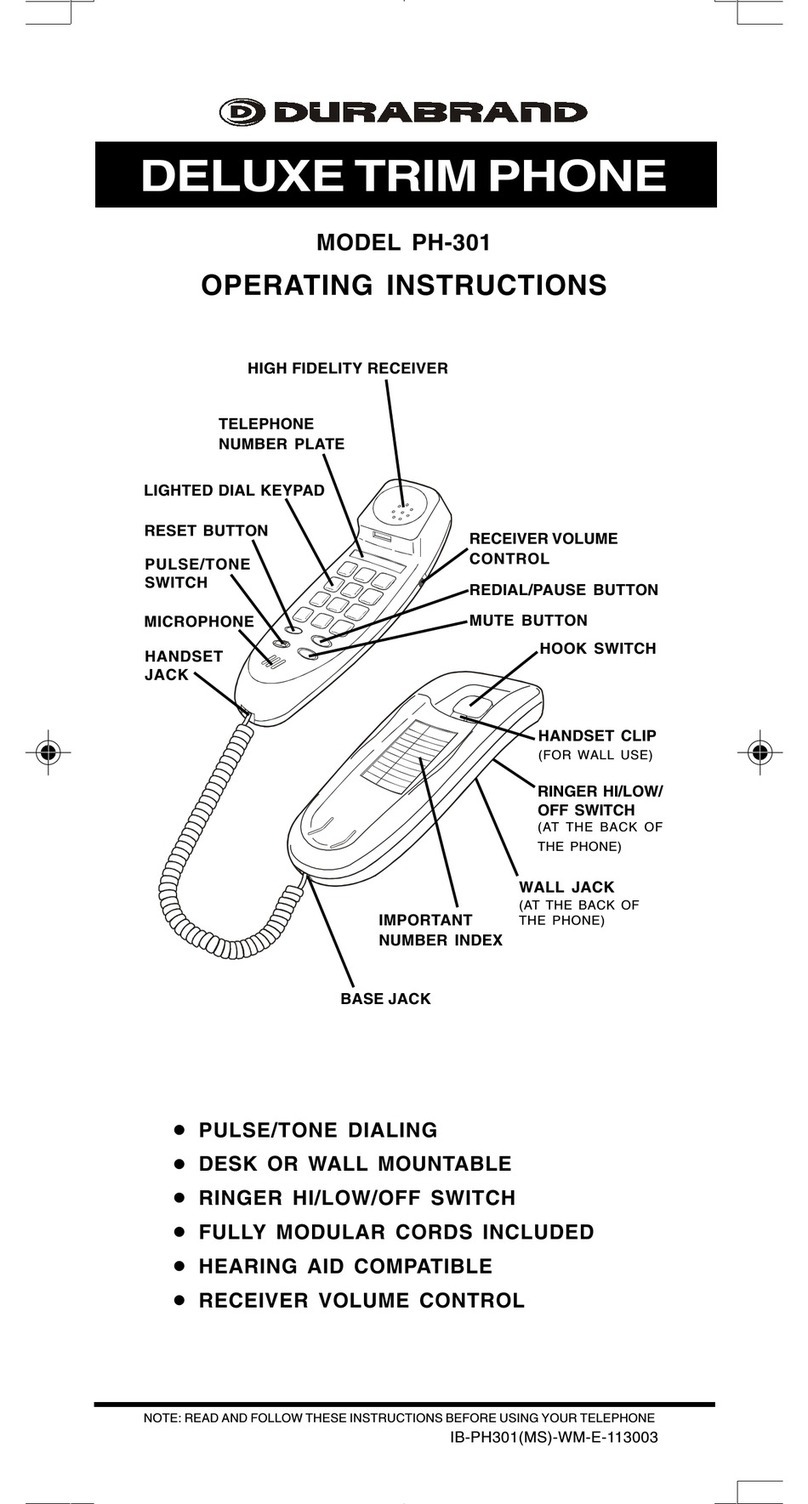Eon Millennium User manual

Converged Communications Platform
Telephone Operating Instructions
Section 32-112-460
Issue 5, July 2008

© eOn Communications Corporation, 1998, 2008. All rights reserved.
185 Martinvale Lane
San Jose, CA 95119
(800) 955-5321 • Fax (408) 694-9600
•••••
www.eoncommunications.com
•••••
This document is for use by authorized eOn customers only and may not be reproduced
in any manner without specific written permission.

1
Telephone Operating Instructions
Contents
Introduction .......................................................................................... 4
Related Documents ................................................................................. 4
Conventions .............................................................................................. 4
General Operating Information ........................................................... 5
Common Terms ......................................................................................... 5
Feature Access ......................................................................................... 5
Audible Call Indications ........................................................................... 5
Resource Queuing ............................................................................... 6
Line Selection ............................................................................................ 6
Telephone Descriptions....................................................................... 9
Millennium Digital Telephones .......................................................................9
Pushbutton Dial .........................................................................................
Feature Buttons .........................................................................................
Display Module .........................................................................................
Button Expansion Module ...................................................................... 16
Recorder Jack......................................................................................... 16
Personal Preferences Setup................................................................... 18
Music Source Selection ....................................................................... 18
Ringer Adjustment ............................................................................... 18
Display Contrast Adjustment .............................................................. 1
Handset Volume Adjustment ............................................................. 1
All Call Announce Volume Adjustment ............................................ 1
Handsfree Speaker Volume Adjustment .......................................... 1
Sidetone Level Adjustment................................................................. 20
Handsfree Operation ............................................................................. 21
Multibutton Electronic Telephones ............................................................... 21
Visual Call Indications ............................................................................ 21
Call Announcer and Controls ............................................................... 21
Background Music .................................................................................. 21
Display Module ....................................................................................... 22
Single-Line Telephones ............................................................................... 24
Feature Access ....................................................................................... 24
Multibutton Access ................................................................................. 24
Second Call Indication .......................................................................... 24
Resource Queuing .................................................................................. 24
Basic Operating Procedures ............................................................. 25
Originating a Call.................................................................................... 25
Answering a Call ..................................................................................... 25
Making Inside Calls ................................................................................. 26
Making Outside Calls.............................................................................. 26
Without Sender-Receiver .................................................................... 26
With Sender-Receiver.......................................................................... 26
Handsfree Operation ............................................................................. 27
Headset/Handset Operation ................................................................ 27
Data Port Dialing..................................................................................... 28

2Telephone Operating Instructions
Feature Operating Instructions......................................................... 29
Alarm Clock............................................................................................. 2
Remote ................................................................................................. 2
Local...................................................................................................... 2
Answer...................................................................................................... 30
Auto Answer ............................................................................................ 31
Auto Transfer ............................................................................................ 31
Busy Prime Line Indication ..................................................................... 31
Button Change ....................................................................................... 32
Call Announce ........................................................................................ 32
All Call Announce ................................................................................... 34
Call Forward ............................................................................................ 35
Local Call Forward .............................................................................. 35
Call Forward Outside System ............................................................. 35
Remote Call Forward .......................................................................... 36
Call Intrusion ............................................................................................ 37
Break-In ................................................................................................. 37
Override ................................................................................................ 38
Call Park ................................................................................................... 3
Call Transfer ............................................................................................. 40
Caller ID Blocking/Unblocking............................................................... 40
Camp-On ................................................................................................ 41
Station Camp-On ................................................................................ 41
Trunk Route Camp-On ........................................................................ 41
Automatic Callback............................................................................ 42
Trunk Auto Camp-On .......................................................................... 42
Answer Hold ......................................................................................... 42
Clear Features ......................................................................................... 42
Clock Set .................................................................................................. 43
Hours and Minutes ............................................................................... 43
Year, Month, and Date ....................................................................... 43
Conference ............................................................................................. 43
Broker's Hold ............................................................................................ 45
COS Change ........................................................................................... 45
Directed Call Pickup............................................................................... 46
Direct Extension Selection...................................................................... 47
Direct Ring Prime..................................................................................... 4
Do-Not-Disturb ......................................................................................... 50
Ground Recall/Hookswitch Flash .......................................................... 51
Hold .......................................................................................................... 51
Hot Line .................................................................................................... 52
Last Number Redial ................................................................................ 52
Least Cost Routing .................................................................................. 52
LCR Special Day...................................................................................... 52
Meet Me Conference ............................................................................ 53
Message Send/Message Retrieve ........................................................ 53
Message Waiting Service ................................................................... 53
Message Center Operation ............................................................... 54
Voice Mail Service ............................................................................... 55
Monitor ..................................................................................................... 55
Music-On-Page ....................................................................................... 56

3
Telephone Operating Instructions
Night Service ........................................................................................... 56
Night Answer ........................................................................................ 56
Night Transfer........................................................................................ 56
Paging ...................................................................................................... 57
Park to Station ......................................................................................... 57
Personal Repertory Dialing..................................................................... 58
Plan Override........................................................................................... 60
Privacy...................................................................................................... 61
Problem Circuit Tagging......................................................................... 62
Remote Call Pickup ................................................................................ 62
General Remote Call Pickup................................................................. 62
Ring Again ............................................................................................... 62
Secretarial Intercom ............................................................................... 63
Station Message Detail Recording (SMDR).......................................... 63
Account Code ..................................................................................... 64
Authorization Code ............................................................................. 64
Account/Authorization Code ............................................................ 65
System Repertory Store .......................................................................... 65

4Telephone Operating Instructions
Introduction
This document describes the telephones that can be used with the Millennium Conv-
erged Communications Platform and provides instructions for placing / answering calls
and accessing the features available with the system. The instructions in this document
apply to the Millennium-style digital, 3100 electronic, and single-line telephones.
This document is being reissued to update company information and the telephone
drawings. Whenever this document is reissued, the reason for reissue will be given in
this paragraph.
For additional information about the Millennium Converged Communications Platform,
refer to the list of related documents in Section 32-112-100.
This symbol indicates a special condition or other important information.
❖This symbol indicates a first-level subparagraph.
●This symbol indicates a second-level subparagraph.
Conventions
Related Documents

5
Telephone Operating Instructions
The following paragraphs provide general information concerning terminology, system
timeouts, user programmable features, and basic telephone operating procedures.
The following terms apply to the telephone operating procedures in this section.
Extension:
This refers to an extension number and may correspond to a single-line
telephone, or a button on a digital telephone or Type 3100 telephone.
Prime Extension:
When an extension number has more than one appearance in the
system, one appearance can be programmed as the primary extension number. This
appearance can be a button on a digital telephone or BEM, or a Type 3100 telephone or
Type 3100 DSS/BLF console, the principal line on a single-line telephone, or a logical
button on a telephone. When a feature such as call announce, station hunt, or directed
call pickup is used, this primary appearance of the extension number is the only location
that responds. When the primary appearance is ringing, all other appearances will
indicate busy. When the telephone with the primary appearance is in the do-not-disturb
mode, all other appearances will indicate ACTIVE.
Second Dial Tone:
Second dial tone, also called transfer hold or distinctive hold dial
tone, consists of three alternations of system dial tone, followed by a steady system dial
tone. You hear second dial tone when you press the TRANSFER HOLD (XFER) or
CONFERENCE HOLD (CONF) button. Depending on system programming, it may also
be used to indicate a waiting message.
Hookswitch Flash:
Holding the hookswitch down for approximately one second, then
releasing it sends a signal to the Central Office to get dial tone after a call has been
terminated by the far end or to initiate a feature. Some telephones have a FLASH button
which can be used instead of pressing the hookswitch. It is much more reliable since it
requires no guessing on the part of the user of the length of time to operate it.
Most system features can be accessed either by dial access code or feature button. A
feature for which a telephone has no button programmed can be accessed by dial code,
provided it is allowed by the telephone’s class-of-service. Table A lists the system default
dial access codes.
Dial access codes are programmable and may be any combination of the digits 0 through
9, #, ✱, A, B, C, and D. If the digits A, B, C, and D are used, buttons for these functions
must be programmed on the multibutton telephones from which the codes will be dialed.
Digits other than 0 through 9 should only be used if all telephones using dial codes use
tone (DTMF) dialing.
All features are assigned time limits to aid in system efficiency. A feature operation must
be completed within the specified time limit. or the selected button or feature is released
for someone else to use or, in a feature such as call forward or hold, the next step in the
sequence begins. If the button or feature is released, the system returns reorder tone.
The tones and signals heard during telephone operation are described in Table B.
General Operating Information
Common Terms
Feature ccess
udible Call Indications

6Telephone Operating Instructions
When an outside call is originated, or a feature that returns dial tone or confirmation tone
is accessed, all the required system resources may not be available. If a resource is not
available, the extension is queued on that resource, and the system returns an alerting
tone repeated at intervals.
When all the necessary resources are available, the the system returns dial tone or
confirmation tone, as appropriate. If the extension is hung up while queued for a resource,
it is taken out of the queue.
A call into the system on a trunk may put the call in the trunk extension queue if the trunk
cannot ring the destination specified in the routing plan. The system gives no indication
that the queue is full; the caller just hears ringback tone.
There are three ways to originate a call with a digital or Type 3100 telephone: manual line
selection, automatic line selection, and preselection. Programming determines how each
telephone functions and which method to use to originate a call. With a single-line
telephone, line selection is always automatic.
Preselection puts a digital or Type 3100 telephone with a SPEAKER button
in the handsfree mode.
Resource Queuing
Line Selection

7
Telephone Operating Instructions
BELBAT
SENOTMETSYS
:SENOTYROSIVREPUS SENOTYCNEUQERFLAUDSENOTYCNEUQERFELGNIS
ENOTECNEDACµwal-Arowal-wal-µµwal-wal-A
enoTlaiD
enoTlaiDevitcnitsiD
enoTysuB
enoTysuBevitcnitsiD
enoTredroeR
enoTnoitamrifnoC
enoTedirrevO
enoTHOM
enoTREM
enoTecnuonnAllaC
enoTrotinoMllaC
enoTno-pmaC
enoTgninraW
suounitnoC
,ffo.sm001,no.sm001
neht,semit6detaeper
enotlaidsuounitnoc
,ffo.sm005,no.sm005
detaeper
05tsaltub,enoTysuBhtiwsA
005sitsrubenothcaefo.cesm
zH
,ffo.sm052,no.sm052
detaeper
,ffo.sm001,no.sm001
semit3detaeper
ffo.ces9.9,no.sm001
,ffo.ces56-1,no.sm05
elbammargorp
elbammargorp,no.ces53556-0
elbammargorp,no.ces6-1
,ffo.ces56-1,no.sm05
elbammargorp
,ffo.ces56-1,no.sm05
elbammargorp
elbammargorp,no.ces6-1
zH044+053
zH044+053
zH026+084
zH026+084
zH026+084
zH044+053
zH084+044
zH084+044
zH084+044
zH084+044
zH084+044
zH084+044
zH005
zH005
zH005
zH005
zH005
zH005
zH005
zH034
zH034
zH034
zH034
zH034
zH034
zH005
zH005
zH005
zH005
zH005
zH005
zH005
(SENOTKCABGNIR)wal-Arowal-µ:
ENOT1ECNEDAC2ECNEDAC3ECNEDAC4ECNEDAC
naciremAenoTkcabgniR,no.ces1
ffo.ces3
,no.ces1
ffo.ces4
,no.ces2
ffo.ces4
,no.ces1
ffo.ces2
naeporuEenoTkcabgniR,no.sm004
,ffo.sm002
,no.sm004
ffo.ces3
,no.sm004
,ffo.sm002
,no.sm004
ffo.ces4
,no.sm004
,ffo.sm002
,no.sm004
ffo.ces5
,no.sm004
,ffo.sm002
,no.sm004
ffo.ces2
ytiroirPwoLenoTkcabgniR,no.sm002
ffo.ces8.3
,no.sm002
ffo.ces8.4
,no.sm002
ffo.ces8.5
,no.sm002
ffo.ces8.2
ysuBnokcabgniRlaicepS retfapeeb.sm05
tsrubgnirlaitini
retfapeeb.sm05
tsrubgnirlaitini
retfapeeb.sm05
tsrubgnirlaitini
retfapeeb.sm05
tsrubgnirlaitini
seicneuqerFenoTzH084+044zH084+044zH084+044zH084+044
:SNRETTAPGNITRELA
:gniwollofehtsallewsa,senotkcabgnirehtfoecnedacehtetacilpudtahtsnrettapgnitrelaeraerehT
kcolCmralA,no.sm002
ffo.sm002
ytiroirPwoLgnitrelA,no.sm002
ELIFORPnoitatsnielbammargorp,ffoces46-1
)snoitats0013SYSroftpecxe(
f82-89wa

8Telephone Operating Instructions

9
Telephone Operating Instructions
The Millennium digital phones are available in 6-, 12-, 18-, and 30-button models. (See
Figures 1 through 4 respectively.) All models include a 12-button dial pad, an electronic
ringer, and, except the 6-button model, a built-in speaker and microphone. All models
may have an optional 2-line by 24-character message display module; the 30-button
telephone can have either a 2-line by 24-character display module or a 4-line by 48-
character display module. The 18- and 30-button models may also have an optional data
adapter, and support a Button Expansion Module (BEM).
The 18- and 30-button telephones have liquid crystal displays (LCDs) next to the feature
buttons to indicate the status of the button. Visual call indications and their meanings are
shown in Table C.
The 6-button telephone supports the Group Listen feature and on-hook dialing, but does
not support handsfree speakerphone operation. The 12-button telephone does support
handsfree operation. Both telephones support off-hook call announce; the announce-
ment is mixed in the receiver with the existing call.
The pushbutton dial on all models of Millennium digital phones is programmed for hot keypad
operation. Any time the telephone is off-hook, the 12 keypad buttons can be used to send
tones (DTMF signals) to the system or to a distant office.
All feature buttons on the digital telephones are programmable, except on the 6-button
model, which has only three programmable buttons. Button functions are determined by
system programming. When the telephone is first plugged in, the software that deter-
mines the function of each button is downloaded from the system.
Digital telephones can have several logical buttons programmed on each physical button,
greatly expanding the button capability at each telephone. Up to 10 banks of buttons can
be programmed, with up to 254 buttons in each bank.
Two models of display modules are available: a 2-line, 24-character-per-line display, and
a 4-line, 40-character-per-line display. The 2-line model shows the top two lines of a 4-
line message. The 4-line model shows all four lines. When the telephone is idle, either
display shows the date/time on the top line and the company logo on the second line.
When the telephone is in use, the display scrolls downward allowing call progress
information to be shown.
The display modules can display additional characters not represented on most key-
boards. All displays use the character patterns shown in Table D. The character set
shown in Table D will be replaced in the future with the character set shown in Table E.
Depending on system programming, call duration may be displayed on the right end of
the display line. A running count is displayed up to 999 minutes and 59 seconds, after
which the timer resets to 999 minutes and 00 seconds and continues counting. When a
trunk call is answered or retrieved, an additional display message is posted for 10
seconds. This message indicates the total time the trunk call has been in the system.
Digital Telephones
Telephone Descriptions
Pushbutton Dial
Feature Buttons
Display Module

10 Telephone Operating Instructions
Figure 1: Millennium 6-Button Digital Telephone
1
3
4
6
awc99-30
25
78
9

11
Telephone Operating Instructions
Figure 2: Millennium 12-Button Digital Telephone
1
6
7
12
awc99-31
2
3
4
5
13 14
8
9
10
11

12 Telephone Operating Instructions
FIgure 3: Millennium 18-Button Digital Telephone
123
45 6
7
0#
89
✱
ABC DEF
GHI JKL MNO
PRS TUV WXY
OPER
1
6
7
EXT
OUT
EXT
208
MSG
MSG
SEND
MUSIC
MUTE
SPKR
CALL
FWD
DND
MEMORY
MENU
HOLD
XFER
CONF
PAR K
PAG E
RLSE
awc2-320
2
3
4
5
8
9
10
11
12
13
14
15
16
17
18
EXT
EXT
MSG
MSG
SEND
MUSIC
MUTE
HOLD
XFER
CONF
PARK
PAG E
RLSE
CALL
FWD
DND
MEMORY
MENU
SPKR
a
wc3-743

13
Telephone Operating Instructions
Figure 4: Millennium 30-Button Digital Telephone
123
456
7
0#
89
✱
ABC DEF
GHI JKL MNO
PRS TUV WXY
OPER
7
12
13
18
EXT
OUT
EXT
208
MSG
MSG
SEND
MUSIC
MUTE
SPKR
DND
MEMORY
MENU
1
6
HOLD
XFER
CONF
PA R K
PA G E
RLSE
CALL
FWD
19
24
25
30
awc92-321
2
3
4
5
awc3-744
1
2
0
11
X
789
456
3
EXT
EXT
MENU
HOLD
CONF
PARK
PAGE
RLSE
XFER
MEMORY
DND
CALL
FWD
SPKR
MUSIC
MUTE
MSG
SEND
MSG

14 Telephone Operating Instructions
TABLE D
MILLENNIUM DIGITAL PHONE DISPLAY
CONDITION
BUSY
ACTIVE
CALLING
P-HOLD
RECALLING
I-HOLD
T-HOLD
ATTENTION
STATION
BUSY
Closed circle displayed continuously.
Closed triangle displayed continuously.
Closed triangle; on/off at 0.5-second intervals.
Open triangle displayed continuously.
Open triangle; on/off at 0.5-second intervals.
Alternating open and closed triangles; open
for 1.5 seconds and closed for 0.5 second.
Alternating open and closed triangles;
changing at 0.5-second intervals.
Alternating open triangle and closed circle;
changing at 0.2-second intervals.
Closed circle displayed 0.8 second on,
0.2 second off.
LCD DISPLAY EXPLANATION
TIME IN SECONDS
0 0.5 1.51.0 2.0
awc91-80
TABLE C
DIGITAL TELEPHONE VISUAL CALL INDICATIONS

15
Telephone Operating Instructions
TABLE E
FORTHCOMING DIGITAL TELEPHONE DISPLAY

16 Telephone Operating Instructions
The Button Expansion Module (BEM) (see Figure 5) connects directly to a digital
telephone or another BEM. It contains 48 programmable buttons arranged in four groups
of twelve. Up to four BEMs can be connected in series to provide a total of 192
programmable buttons, resulting in a 210-button station when associated with an 18-
button telephone, or a 222-button station when associated with a 30-button telephone.
The BEM can be equipped with a display module. The information shown on the display
complements the information shown on the display of the companion telephone. When
the telephone is idle, the BEM display is blank and the idle state information appears on
the telephone display. When the telephone is in use, call status information in lines three
and four of the 4-line, 24 characters-per-line message is shown on the telephone display
and the idle state information in lines one and two appears on the BEM display.
The 30-button telephone can be equipped to connect to recording equipment that records
both sides of calls.
Button Expansion Module
Recorder Jack

17
Telephone Operating Instructions
Figure 5: Button Expansion Module
19
31
24
36
25
37
30
42
31
43
36
48
42
54
61
73
55
67
49
61
43
55
48
60
54
66
60
72
66
78
37
49
AWC2-195

18 Telephone Operating Instructions
The following items can be programmed at each telephone:
❖Background music source and volume level.
❖Ringer volume level and ring type.
❖Display module contrast.
❖Handset receiver volume level.
❖Speaker volume level (handsfree and call announce).
❖Sidetone level.
To select the background music source and adjust the volume level:
❖With the handset on-hook, press the MUSIC/MUTE button one or more times to
select music source 1 or 2, or no music.
❖Press the UP ARROW or DOWN ARROW button to adjust the volume level.
For about 3 seconds after pressing the MENU button, you can use the UP ARROW or
DOWN ARROW button to scroll through the modes. At the end of that time, the telephone
will go into the selected mode for about 10 seconds. Afterward, the display will change
and the telephone will return to its idle state. If the telephone goes into one of the selection
modes, the UP ARROW and DOWN ARROW button indicators will change to ACTIVE
or BUSY, indicating that the buttons can now be used to set the ring level, ring type, or
display contrast. In either of the two ring modes, the ringer will ring.
To set the ringer volume level and ring type:
❖With the telephone on-hook and idle (even the MUSIC button displays nothing),
press the MENU button.
❖Within about 3 seconds, if necessary, press the UP ARROW or DOWN ARROW
button one or more times until the message
Mode = ring level select
is displayed.
Wait for the UP ARROW and DOWN ARROW button indicators to change to
ACTIVE and for the ringer to ring.
❖Press the UP ARROW or DOWN ARROW button to increase or decrease the
ringer volume level. When the maximum or minimum volume is reached, the
related button indicator changes to BUSY.
❖When the ringer volume is satisfactory, press the MENU button or wait for the 10-
second timeout to save the choice and exit the ring level select mode. The ringer
is silenced and the UP ARROW and DOWN ARROW button indicators change to
IDLE.
❖Press the MENU button again.
❖Within about 3 seconds, if necessary, press the UP ARROW or DOWN ARROW
button one or more times until the message
Mode = ring type select
is displayed.
Wait for the UP ARROW and DOWN ARROW button indicators to change to
ACTIVE and for the ringer to ring.
❖Press the UP ARROW or DOWN ARROW button to change the ring type.
Personal Preferences Setup
Music Source Selection
Ringer Adjustment
Table of contents



